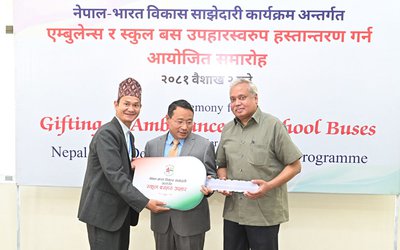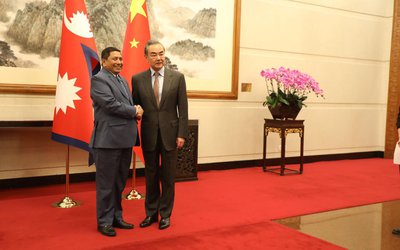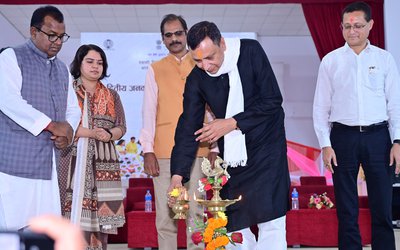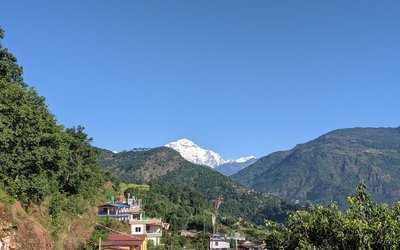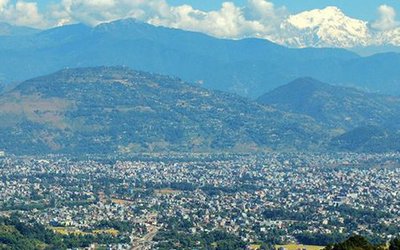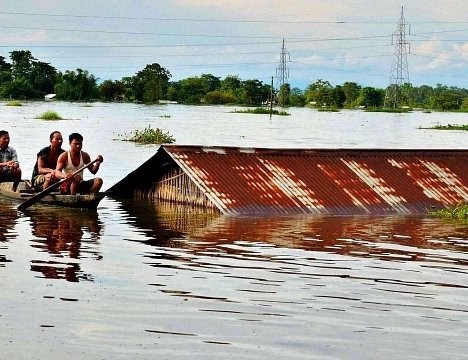
As a country with diverse geography, difficult terrain and highly varying climate, Nepal is prone to several natural disasters. The World Bank has classified Nepal as one of the global "hot spots" for natural disasters. According to the Global Climate Risk Index, Nepal ranks in the 4th position globally in terms of climate risk. The topography of Nepal, varying from the Himalayan range, Hilly region to the flat Terai plains is such that it creates a diverse setting for various kinds of disasters to occur. Terai region is susceptible to seasonal flooding due to monsoon rain; mountain and hilly regions on the other hand are prone to landslides whereas all the three regions are affected by frequently occurring earthquakes.
Amongst all, the monsoon-induced disasters are most appalling in Nepal. From the period between June and September which is the monsoon season, most of the devastating floods have occurred in Nepal in recent years. Historical events show that flooding has caused the most significant human fatalities as well as economic loss in Nepal. As per the report by the United Nations, during the 2017 monsoon flood in Nepal, approximately 1.7 million people across the Terai region were severely affected, including the death toll of 169 and 460000 people being displaced from their homes. Government figures show that 79812 houses were destroyed and 144444 houses were damaged during the 2017 flooding.
2020 monsoon has also started already and it has triggered floods and landslides in several parts of the country. As per the Nepal Disaster Risk Reduction Portal, 15 floods and 74 landslides have occurred in Nepal over the last week. Following the widespread flooding and landslides, a massive number of casualties and destructions have occurred and are still continuing. As of 15 July 2020, 116 fatalities have occurred, 50 people are missing and 138 citizens have been injured, says Disaster Risk Reduction Authority in Nepal. In addition to this, 300 houses have been already damaged by the disaster.
While every group of the population has been affected by the disaster, the impact of it is not gender-neutral. Though men and women are affected by the disaster in the same way, their vulnerabilities to the risk imposed by the disaster are more profound in women than in men. Similarly, the pre-existing discrimination and inequality to the people with disabilities, minorities and disadvantaged groups (DAGs) further worsen during the time of such crisis. Evidence shows that gender-based disparity and violence are often reinforced and perpetuated by the disasters leading to lower mechanisms for resilience and recovery to the most vulnerable groups. Women, minorities and DAGs' increased vulnerabilities to the disasters have many dimensions to it. In the case of women, their reproductive roles can limit their survival during disasters. Women on the final stage of pregnancy, postpartum and those with newly born babies or young children are more prone to lose their lives in the times of natural hazards. People with physical disabilities may be left behind at the time of such a crisis considering their inability to independently move and save themselves.
Socially constructed roles are also gendered creating inequality between men and women which increases during the times of disaster. Unequal accessibility to information between men and women leads to women being unable to receive early warnings during natural hazards compared to men. Their household dynamics and domestic roles limit their ability to take prompt actions and escape when disasters like floods and landslides occur. Basic life skills like swimming, in many contexts, are mainly taught to and practiced by men and boys and less by women and girls. Because of the lack of such survival skills, a higher number of women and girls tend to lose lives. Furthermore, the responses to the vulnerabilities as well as their coping and recovery strategies also differ between men and women. Under-representation of women and marginalized groups at the policy and decision-making levels aggravate gender inequality and exclusion preventing the reduction of disaster-related risks in vulnerable groups.
The government of Nepal has formulated several laws and taken various measures for the management of natural disasters within the country. The formulation and implementation of the National Strategy for Disaster Risk Management (NSDRM) in the year 2009 is one of them, which is aimed at mainstream disaster risk reduction activities in Nepal. In the past, most disaster management efforts were just limited to rescue and relief. However, in recent years we have been witnessing a paradigm shift towards other aspects of disaster management. The Government of Nepal formulated the Disaster Risk Reduction and Management Act 2017 to address disaster risk management with a multidisciplinary approach in order to focus on different stages in the cycle of disaster management starting with preparedness, mitigation, response to rehabilitation. Similarly, the National Disaster Risk Reduction and Management Authority (NDRRMA) was established in the year 2019 which deals with disaster-related issues during the different phases of the disaster including prior to the disaster phase, during the disaster and post-disaster phases, having coordination with National, District and Local Level Disaster Management Committees. With all these efforts, a lot of progress has been done in Nepal with regard to disaster-related issues, but despite of this, there are no specific laws or policies to explicitly address gender perspective in disaster risk reduction and management to date. Failing to address gender inequalities in disaster risk reduction and management programs will be rendered inadequate hence it is vital that gender perspective should be considered in all aspects of the disaster phase.
Way forward
Gender mainstreaming should be embedded in all plans, policies and decision-making processes. Special concentration needs to be given to gender equality in Disaster Risk Reduction (DRR) in order to create a resilient and sustainable community. Integrating the gender perspective in DRRis a fundamental component to achieving sustainable development. A risk assessment which is a vital component of the DRR should be undertaken in a gender-responsive manner. The role of women in the crisis communication in disaster management is very limited in Nepal, hence this must be promoted at all levels. In the post-recovery phase too, women and vulnerable groups' involvement needs to be encouraged and enhanced. Furthermore, all the reconstruction and livelihood restoration program needs to have gender-inclusive participation. In local disaster risk management committees, at least 40 percent of women's participation needs to be promoted.
Effectual capacity strengthening training need to be given to women and girls to apply to cope up with the disasters and smoothly adapting through its after-effects. Women covering half of the population of the world, have the capability to lead the disaster preparedness, coping strategies and recovery initiatives. We can take examples from other countries who have gone through disasters in the past like Indonesia and Vietnam. Following the 2007 flood in Jakarta, women occupying the informal urban settlements set up an emergency kitchen to cook and distribute meals to other affected residents of the community. Similarly, women in Vietnam are active in engaging the community and helping to set up technical training on DRR and early disaster warning systems. In Nepal as well, community engagement led by women can play a vital role in coping up with the disasters.
The conventional approach of the historical trend analysis of the disasters has been fruitful to some extent in the management of risks associated with several disasters in the past in Nepal. But with the onset of the heath pandemic COVID-19, this approach might not be sufficient enough to deal with the current situation. In the present scenario, it is vital that a holistic multi-hazard approach to disaster management needs to be adopted. Natural hazards like floods and landslides should be managed simultaneously keeping in mind the risks related to the COVID-19. The possible chances of other disasters like earthquakes should also not be disregarded as for Nepal being one of the earthquake-prone countries in Asia and the Pacific. Furthermore, as the resources and funding have been already overwhelmed due to COVID-19 health-crisis, the special budget needs to be allocated for ongoing natural disasters like floods and landslides. A comprehensive and coordinated approach needs to be adopted at the provincial and local levels to ease the process of handling natural disasters in the context of ongoing COVID-19. Prioritizing women, vulnerable and marginalized populations should be of the top-most priority so that these groups have equal access to the response services without discrimination. Specific needs of the vulnerable population need to be met so that no one is left behind in the overall disaster management process.
The author holds a Master of Science degree in Gender and Development Studies from the Asian Institute of Technology (AIT), Thailand.
- Youth In Politics: A Present Day Context
- Apr 24, 2022
- Turning The Tide: Addressing Gender Biases In Media
- Aug 25, 2021
- How COVID-19 Threatens The Future Of The Children, Especially Young Girls?
- Apr 25, 2021
- Women's Representation In Politics: Just A Tokenism
- Feb 06, 2021
- Women Migrant Workers And Their Human Rights
- Dec 27, 2020





